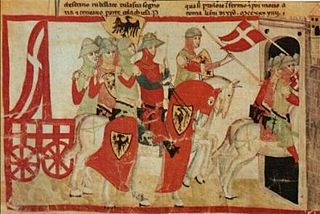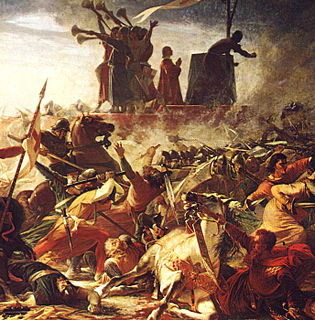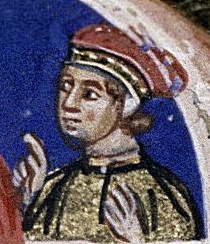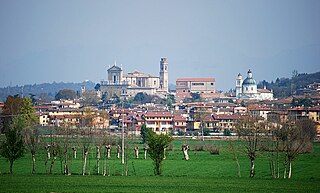The siege
After an ultimatum sent by Frederick on 2 February 1159, asking the destruction of their walls, was refused, the Cremaschi settled into their city to hold against a siege. Barbarossa killed his prisoners, so the Cremaschi hacked their prisoners to pieces in front of their comrades. [5]
The besieging troops were formed mostly by Barbarossa's imperial contingents, part of which led by his brother, Conrad, and by the latter's son Frederick; by Bavarian troops under duke Henry the Lion; and by communal troops, mostly belonging to the main imperial allies, Cremona (under bishop Oberto of Dovara) and Pavia. The city was on a marshy plain and was protected by several moats and a tall double wall. The defenders had nine mangonels as defensive artillery. Milan attempted to save Crema by assaulting a nearby town, but Barbarossa drove back the Milanese.
The besiegers set in their final positions in the October 1159; starting from the following December, they used a "cat" (a mobile roof), followed by a siege tower, to cover their siege engineers who were mining under the walls. This led to the Cremaschi also digging tunnels to start underground warfare. After the cat had eroded the walls, a ram was used to create a breach in the walls; the tower was further neared to the walls starting from 6 January. The final assault was launched on January 21 using a mobile bridge measuring some 24 x 3.5 meters, while a smaller one was launched from the siege tower.
The defenders and civilians, some of whom had died of hunger and disease, surrendered on January 25 after the imperial troops had taken control of the outer walls. Some 20,000 survivors were allowed to leave with whatever they could carry before Crema was looted and burnt to the ground. An edict issued by Frederick in 1162 at Lodi officially forbade its reconstruction.
Milan was also taken and destroyed two years later, ending the first phase of the war. Crema could be rebuilt by its citizens after the signature of the Peace of Constance in 1183.

Cremona is a city and comune in northern Italy, situated in Lombardy, on the left bank of the Po river in the middle of the Pianura Padana. It is the capital of the province of Cremona and the seat of the local city and province governments. The city of Cremona is especially noted for its musical history and traditions, including some of the earliest and most renowned luthiers, such as Giuseppe Guarneri, Antonio Stradivari, Francesco Rugeri, Vincenzo Rugeri, and several members of the Amati family.

The Lombard League was a medieval alliance formed in 1167, supported by the popes, to counter the attempts by the Hohenstaufen Holy Roman emperors to assert influence over the Kingdom of Italy as a part of the Holy Roman Empire. At its apex, it included most of the cities of Northern Italy, but its membership changed with time. With the death of the third and last Hohenstaufen emperor, Frederick II, in 1250, it became obsolete and was disbanded.

The Battle of Cortenuova was fought on 27 November 1237 in the course of the Guelphs and Ghibellines Wars: in it, Holy Roman Emperor Frederick II defeated the Second Lombard League.

The Battle of Legnano was a battle between the imperial army of Frederick Barbarossa and the troops of the Lombard League on May 29, 1176, near the town of Legnano in present-day Lombardy, in Italy. Although the presence of the enemy nearby was already known to both sides, they suddenly met without having time to plan any strategy.

The War of the League of Cambrai, sometimes known as the War of the Holy League and several other names, was fought from February 1508 to December 1516 as part of the Italian Wars of 1494–1559. The main participants of the war, who fought for its entire duration, were France, the Papal States, and the Republic of Venice; they were joined at various times by nearly every significant power in Western Europe, including Spain, the Holy Roman Empire, England, the Duchy of Milan, the Republic of Florence, the Duchy of Ferrara, and the Swiss.
Victor IV was elected as a Ghibelline antipope in 1159, following the death of Pope Adrian IV and the election of Alexander III. His election was supported by the Emperor Frederick Barbarossa. He took the name Victor IV, not accounting for Antipope Victor IV of 1138, whose holding of the papal office was deemed illegitimate.

Galdino della Sala, Galdinus or Galdimus, was a Roman Catholic saint from Milan in northern Italy. He was a cardinal elevated in 1165 and he also served as Archbishop of Milan from 1166 to his death in 1176. He was a staunch supporter both of Pope Alexander III, and of Milan and its neighbours in Lombardy, in their joint and parallel struggles against the Antipope Victor IV, supported by Holy Roman Emperor Frederick I Barbarossa.

The Golden Ambrosian Republic was a short-lived government founded in Milan by members of the University of Pavia with popular support, during the first phase of the Milanese War of Succession. With the aid of Francesco Sforza they held out against the forces of the Republic of Venice, but after a betrayal Sforza defected and captured Milan to become Duke himself, abolishing the Republic.

The Battle of Bicocca or La Bicocca was fought on 27 April 1522, during the Italian War of 1521–26. A combined French and Venetian force under Odet de Foix, Vicomte de Lautrec, was decisively defeated by an Imperial–Spanish and Papal army under the overall command of Prospero Colonna. Lautrec then withdrew from Lombardy, leaving the Duchy of Milan in Imperial hands.

Crema is a city and comune in the province of Cremona, in the region of Lombardy in northern Italy. It is built along the river Serio at 43 km (27 mi) from Cremona. It is also the seat of the Catholic Bishop of Crema, who gave the title of city to Crema.

Beatrice I was Countess of Burgundy from 1148 until her death, and was also Holy Roman Empress by marriage to Frederick Barbarossa. She was crowned empress by Antipope Paschal III in Rome on 1 August 1167, and as Queen of Burgundy at Vienne in August 1178.

A carroccio was a large four-wheeled wagon bearing the city signs around which the militia of the medieval communes gathered and fought. It was particularly common among the Lombard, Tuscan and, more generally, northern Italian municipalities. Later its use spread even outside Italy. It was the symbol of municipal autonomy. Priests celebrated Mass at the altar before the battle, and the trumpeters beside them encouraged the fighters to the fray.

The Wars in Lombardy were a series of conflicts between the Republic of Venice and the Duchy of Milan and their respective allies, fought in four campaigns in a struggle for hegemony in Northern Italy that ravaged the economy of Lombardy and weakened the power of Venice. They lasted from 1423 until the signing of the Treaty of Lodi in 1454. During their course, the political structure of Italy was transformed: out of a competitive congeries of communes and city-states emerged the five major Italian territorial powers that would make up the map of Italy for the remainder of the 15th century and the beginning of the Italian Wars at the turn of the 16th century. They were Venice, Milan, Florence, the Papal States and Naples. Important cultural centers of Tuscany and Northern Italy—Siena, Pisa, Urbino, Mantua, Ferrara—became politically marginalized.

The Battle of Castiglione took place near Castiglione delle Stiviere in Lombardy, Italy on 8 September 1706 during the War of the Spanish Succession. A French army of 12,000 attacked a Hessian corps of 10,000 that was besieging the town and forced them to retreat with heavy losses.

The siege of Leuven was an important siege in the Thirty Years' War in which a Franco-Dutch army under Frederick Henry of Orange and the French Marshals Urbain de Maillé-Brezé and Gaspard III de Coligny, who had invaded the Spanish Netherlands from two sides, laid siege to the city of Leuven, defended by a force of 4,000 comprising local citizen and student militias with Walloons, Germans, Spanish and Irish of the Army of Flanders under Anthonie Schetz, Baron of Grobbendonck. Poor organization and logistics and the spread of sickness among the French, along with the appearance of an Imperial-Spanish relief army of 11,000 under Cardinal-Infante Ferdinand and Ottavio Piccolomini, forced the invading army to lift the siege. This failure allowed the Spanish forces to take the initiative and soon the invaders were forced into a headlong retreat.

Barbarossa is a 2009 Italian English-language film set primarily in northern Italy during the late 12th century. Despite the film's title, Friedrich "Barbarossa" features only as a supporting character in this film, which is primarily concerned with the struggle of the Lombard League, which struggled to maintain independence from the Holy Roman Empire, led by the legendary Guelph warrior Alberto da Giussano.
Guido da Landriano, or Landriani (Just checked now on the DOP, was an Italian condottiero and politician. He held the position of consul of the city of Milan and was the military leader of the troops of the Lombard League during the battle of Legnano. Alberto da Giussano, who according to tradition, was in command of the Lombard League, is in fact a legendary figure.
The siege of Tortona in 1155 was the first major military engagement resulting from Holy Roman Emperor Frederick Barbarossa's ambition to enforce Imperial hegemony in Italy.
The war of Milan against Como, sometimes called the 10-Year War, was a conflict over the control of Insubria, Brianza and Valtellina in the early 12th century, fought between the comuni of Milan and Como. It resulted in the defeat and destruction of the latter, cementing Milan's position as the dominant power in Lombardy.
The Milan–Lodi War was a conflict fought in the early 12th century between the Lombard comuni of Milan and Lodi, resulting in the defeat and destruction of the latter.















